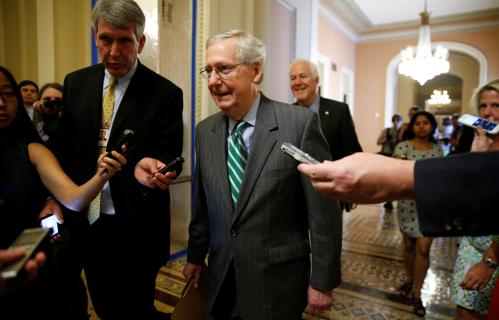This analysis is part of USC-Brookings Schaeffer Initiative on Health Policy, which is a partnership between the Center for Health Policy at Brookings and the USC Schaeffer Center for Health Policy & Economics. The Initiative aims to inform the national health care debate with rigorous, evidence-based analysis leading to practical recommendations using the collaborative strengths of USC and Brookings.
On Thursday, Senate Republicans unveiled the Better Care Reconciliation Act (BCRA), its Affordable Care Act (ACA) repeal bill. One provision of that legislation would greatly expand states’ ability to waive a range of provisions of federal law that affect health insurance. As both my Brookings colleague Jason Levitis and Nicholas Bagley have explained in pieces published earlier today, states would need to meet only very weak standards in order to obtain a waiver under the Senate bill, and waivers could have wide-ranging implications for the extent and affordability of insurance coverage.
One potential effect of these state waivers is weakening a pair of protections against catastrophic costs included in the ACA. In particular, states can directly use this expanded waiver authority to eliminate the requirement that individual and small group plans cap annual out-of-pocket spending. States can also indirectly weaken or effectively eliminate both the ACA’s requirement that plans limit out-of-pocket spending and its ban on individual and lifetime limits by setting a definition of “essential health benefits” that is weaker than the definition under current law. Both of these protections against catastrophic costs apply only with respect to care that is considered essential health benefits, so as the definition of essential health benefits narrows, the scope of these protections narrows as well.
Allowing states to change the definition of essential health benefits unavoidably weakens these protections against catastrophic costs in waiver states’ individual and small group markets. But waivers’ effects could also cross state lines and weaken these protections for people covered by large employer plans in every state.[1] Under current regulations, large employer plans are allowed to choose the definition of essential health benefits in effect in any state in the country for the purposes of determining the scope of these protections against catastrophic costs. If the Trump Administration maintains that approach as it implements the BCRA and even one state uses the waiver process under the BCRA to set a lax definition of essential health benefits, then these protections against catastrophic costs could be weakened or effectively eliminated for people working for large employers nationwide.
The potential effects of the the BCRA waiver provisions on the ACA’s protections against catastrophic costs are essentially identical to those of a waiver provision included in the House-passed American Health Care Act (AHCA), which I have written about previously. The only substantive difference is that the Senate version would allow states to directly waive the out-of-pocket maximum requirement for some plans; under the House-passed bill, states could only affect this requirement indirectly by changing the definition of essential health benefits.
The remainder of this blog post examines these issues in greater detail.
The ACA’s Protections Against Catastrophic Costs and the Linkage to Essential Health Benefits
The ACA generally prohibited private insurance plans, including individual market plans and plans offered by employers of all sizes, from imposing annual or lifetime limits on the dollar amount of care they would cover and required plans to cap enrollees’ annual out-of-pocket spending.[2] Both of these provisions aim to ensure that seriously ill people can access needed health care services while continuing to meet their other financial needs, as my Brookings colleagues Loren Adler and Paul Ginsburg have discussed.
As Adler and Ginsburg note, a majority of employer plans imposed lifetime limits prior to the ACA’s enactment, and more than one-sixth lacked limits on out-of-pocket spending. Similarly, a recent survey of large employers found that 20 percent “agree or strongly agree” that they would impose annual limits if given the option to do so, while 15 percent said the same about annual limits.
The scope of these protections against catastrophic costs is closely linked to the definition of essential health benefits. (That definition also serves another important function under the ACA: determining what services must be covered by individual and small group market plans). In particular, the ACA’s ban on annual and lifetime limits only applies with respect to services that are considered essential health benefits. Similarly, the ACA only requires that plans cap enrollees’ annual out-of-pocket spending on care that is considered essential health benefits. Thus, as the definition of essential health benefits narrows, the scope of these requirements narrows as well. Indeed, if nothing was an essential health benefit, then these requirements would be completely meaningless.
Under current regulations, each state gets to select its definition of essential health benefits from a menu of options provided by the federal government tailored to that state. The menu available to each state was designed to ensure that all of the options available to the state meet the basic requirements under the statute. Nevertheless, because each state’s menu is different and each state makes its own selection off of that menu, the result is that the definition of essential health benefits does vary to some degree from state to state even under current law.
For individual and small group market plans, this does not create any ambiguity: the definition of essential health benefits that applies for the purposes of the protections against catastrophic costs is simply the definition chosen by the state in which that policy is issued. But the situation is more complicated for large employer plans. These plans are not subject to essential health benefit requirements when determining what types of health care services they must cover, and these plans frequently cover individuals working in multiple different states. Furthermore, the general approach taken under federal law is to shield large employer plans from state-specific regulation.
In light of these considerations, current regulations and guidance take a permissive approach that allows large employer plans to apply the definition of essential health benefits in effect in any state’s individual and small group markets when determining the scope of the ban on annual and lifetime limits and the requirement to cap out-of-pocket spending.[3] Notably, employers are not limited to choosing states in which they have facilities or employees; they can choose any state in the country.
Implications of Changes to the Section 1332 Waiver Process Under the BCRA
Section 1332 of the ACA allows states to seek State Innovation Waivers, which permit them to waive a wide variety of major ACA provisions, including the ACA’s out-of-pocket maximum requirement and the definition of essential health benefits. To secure those waivers, however, states must demonstrate that their proposal would cover at least as many people, provide coverage that is at least as affordable and comprehensive, and not increase the federal deficit.
The BCRA would make radical changes to the Section 1332 process. As both Levitis and Bagley discuss in detail, the BCRA would remove most of the requirements to secure a waiver and require only that waivers not increase the federal deficit. The BCRA would also require the federal government to approve any waiver that met this criterion, stripping it of the discretion it has under current law.
The BCRA’s changes to the Section 1332 process would jeopardize both the ACA’s out-of-pocket maximum requirement and the ban on annual and lifetime limits. Most directly, states could now use Section 1332 to directly eliminate the requirement that plans cap annual out-of-pocket spending for plans in their individual and small group markets.[4] While states could technically have waived the out-of-pocket maximum requirement under current law, it would likely have been challenging to do so without running afoul of the requirements that coverage under the waiver be at least as comprehensive and at least as affordable as coverage absent the waiver.
States could also indirectly weaken both the out-of-pocket maximum requirement and the ban on annual and lifetime limits by using Section 1332 to redefine essential health benefits, which, as described above, is what determines the scope of these protections against catastrophic costs.[5] As above, while states could technically have redefined essential health benefits under the pre-BCRA version of Section 1332, it would have been challenging to do so without running afoul of the requirement that coverage under the waiver be at least as comprehensive as coverage absent the waiver.
States decisions to modify the definition of essential health benefits through Section 1332 would clearly affect the scope of the ban on annual and lifetime limits and the requirement to limit out-of-pocket spending for individual and small group market plans in waiver states. However, if large employer plans continue to be allowed to select any state’s definition of essential health benefits for the purposes of the out-of-pocket maximum requirement and the ban on annual and lifetime limits, then the effects could reach large employer plans anywhere in the country.
To be concrete, suppose that even one state secured a waiver that allowed it to drop prescription drugs from the definition of essential health benefits—a plausible scenario since these services were commonly not covered in individual market plans prior to the ACA. In this case, a large employer plan that wanted to impose an annual or lifetime on limit on prescription drugs could simply adopt that state’s definition of essential health benefits. A large employer plan that did not want to limit enrollees’ out-of-pocket spending with respect to these services could do the same. In a more extreme, but still plausible, scenario in which even one state elected to completely eliminate essential health benefit standards, the requirement to provide these protections could disappear entirely for large employer plans nationwide.
Could the Trump Administration Limit These Effects? Would It?
One natural question is whether the Trump Administration could block waivers provided under the BCRA from having these effects. In some instances, the answer is unambiguous. The Trump Administration would have no ability to block states from using the enhanced waiver authority provided under the BCRA to weaken or eliminate the out-of-pocket maximum requirement within its individual and small group markets. Nor it could it prevent states’ modifications to the definition essential health benefits from undermining the ban on annual and life time limits and the out-of-pocket maximum requirement with their individual and small group markets.
The Trump Administration likely could, however, craft the regulations implementing the BCRA so as to keep one state’s essential health benefit waiver from affecting large employer plans nationwide.[6] For example, rather than maintaining the current approach of allowing large employer plans to choose the definition of essential health benefits in effect in any state, the administration could instead only allow employers to choose among definitions of essential health benefits in effect in non-waiver states. Indeed, after similar concerns were raised regarding the effects of the House-passed American Health Care Act, a spokesperson for the Department of Health and Human Service suggested that it would regulate in such a way as to avoid this outcome.
However, it is far from clear that the administration would choose to do so in practice. In light of the administration’s general commitment to deregulation, the President’s executive order that agencies should provide maximum regulatory flexibility when implementing ACA provisions, and the President’s strong support for allowing insurance plans to be sold across state lines, it seems likely that the administration would continue to allow large employers to choose freely among state standards. In that case, the BCRA’s enactment would greatly weaken the ACA’s guarantee of protection against catastrophic costs in large employer plans nationwide.
[1] For simplicity, this piece uses the term “large employer plan” to refer to employer coverage other than small group market coverage, a category that includes both self-insured coverage and large group insured coverage. This category includes a small number of self-insured plans offered by small employers.
[2] The ban on annual limits does not apply to grandfathered individual market plans. The requirement to cap annual out-of-pocket spending does not apply to grandfathered plans in any market.
[3] Employers are also permitted to choose a definition of essential health benefits that matches the set of services covered by certain plans offered through the Federal Employee Health Benefits Program.
[4] There is some ambiguity about whether and how state waivers of the out-of-pocket maximum requirement would affect large employer plans.
[5] Most state waivers changing the definition of essential health benefits would likely do so by waiving Section 1302(b) of the ACA. The annual and lifetime limit provisions of the ACA define essential health benefits by reference to Section 1302(b) and the out-of-pocket maximum requirement implicitly does the same, so waivers of this type would affect these provisions. However, certain state waivers related to essential health benefits could be achieved by waiving Section 1302(a) rather than Section 1302(b). In those cases, a state’s waiver of essential health benefits might not affect the scope of these protections against catastrophic costs.
[6] The Trump Administration likely could not avoid making some affirmative decision about its desired policy outcome in the course of implementing the BCRA. In particular, the likely appearance of state waivers of the definition of essential health benefits would necessitate conforming changes to the federal regulations that define essential health benefits. Its approach to doing so would determine the effects on these other provisions.






Commentary
Like the AHCA, the Senate’s health care bill could weaken ACA protections against catastrophic costs
June 23, 2017